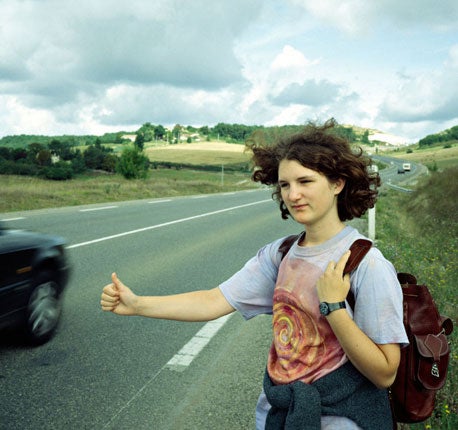Thumbs-down from drivers means end of the road for hitching

There was a time when a wind-battered man optimistically jutting his thumb into the air was a common sight on Britain's roadsides. Nor was it unusual for drivers to actually stop and offer a lift.
But the road has become a lonely place for the once-ubiquitous hitch-hiker. As many as 91 per cent of drivers now say they would be unlikely to stop and offer a free ride to a stranger – up from 75 per cent just two years ago, according to a new AA survey.
The rise of cut-price coach travel and expanding car ownership have been blamed for putting the final nail in the coffin of an idyll of free-and-easy wayfaring that has been in decline for many years.
Only one in every hundred drivers say they would be very likely to stop and offer a free lift, and the same small fraction (mostly the same people, in fact) have hitch-hiked themselves in the past year, according to the poll of more than 16,000 people.
Edmund King, the president of the AA, said hitch-hiking had "reached the end of the road". "As teenagers my brothers and I would hitch-hike around the UK and Europe," he said. "But one rarely sees a hitch-hiker today. The older generation are more likely to have thumbed a lift and hence are more likely to pick up hitch-hikers."
The youth of today, however, are more likely to be wilfully ignoring hitch-hikers than taking to the roadside themselves. Ninety-three per cent of 18-24-year-olds have never tried it, whereas more than half of 48-65 year-olds say they have. For men and women of a certain age, hitch-hiking was more than just a cheap way to get about; it was a lifestyle choice. The poor, wayfaring stranger was an iconic figure of 60s and 70s counter-culture, informed and inspired by Jack Kerouac's On The Road and channelled through the lyrics of Joan Baez, Simon & Garfunkel and Bob Dylan to become a widely-used mode of transport for a generation of British students.
A boom in university entry, combined with a pre-motorway transport infrastructure and high car prices, fuelled a subculture of hitchers. In 1979, The Independent's current senior travel editor, Simon Calder, wrote The Hitch-hiker's Manual: Britain, in which he estimated that it would take a single woman only 15 minutes to hitch a ride, and even a group of three men could reasonably expect to be picked up within an hour and a half.
However, with the spread of motorways, where pedestrians are banned, better public transport and the expansion of car ownership, the hitch-hiker soon became an endangered species. The practical benefits of giving a ride – a navigator and some company – have been superseded by satnav and vastly improved in-car entertainment.
The AA's survey did contain one ray of hope for the would-be hitcher. A so-called "Celtic friendly" attitude was identified, with drivers in Wales, Scotland, Northern Ireland and the West Country much more likely to pick up a hitch-hiker than in other parts of the country.
Join our commenting forum
Join thought-provoking conversations, follow other Independent readers and see their replies
Comments